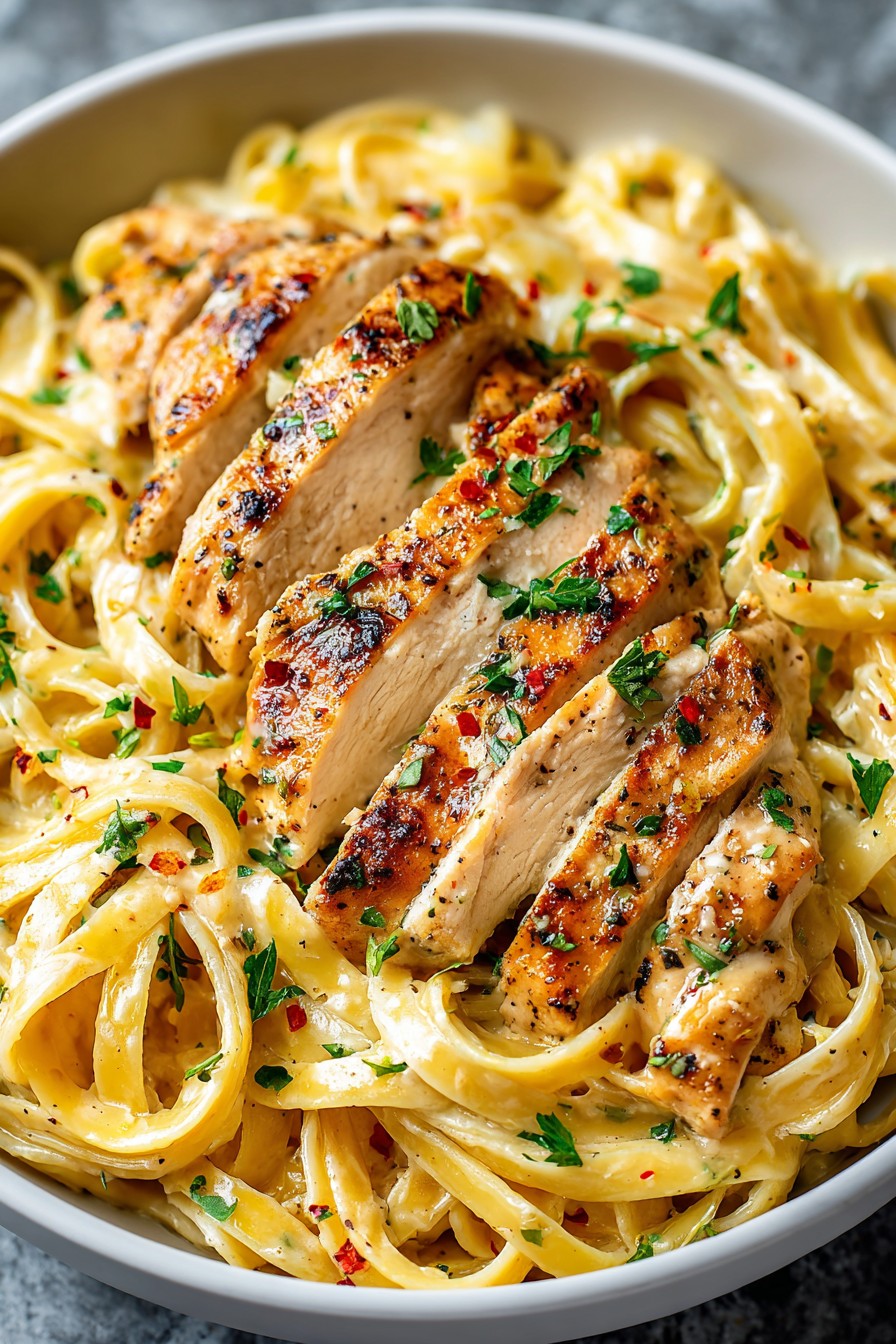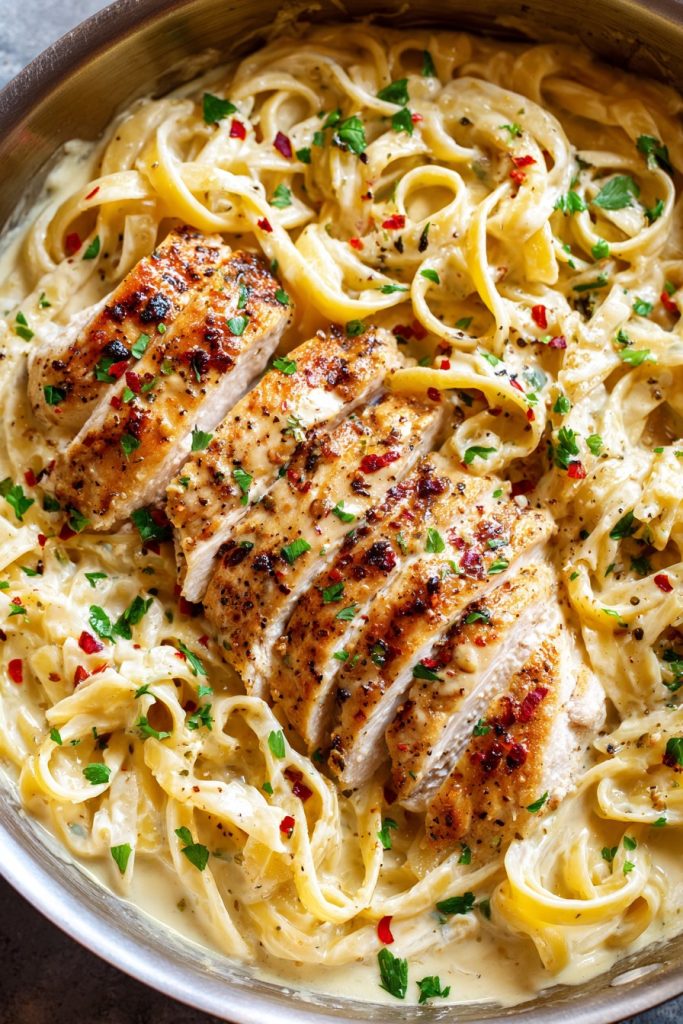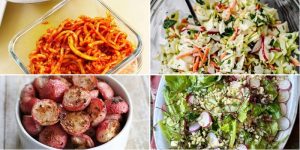Settle in, pasta lovers, because I’m about to share the ultimate chicken alfredo recipe that will make you feel like an Italian nonna without the years of practice. Seriously, this dish is so creamy and dreamy that you’ll want to eat it straight from the pan—and I won’t judge if you do! It’s the perfect weeknight dinner that feels fancy enough for date night but easy enough for those “I can’t even” evenings.
Why This Recipe Works
- Using freshly grated Parmesan cheese instead of pre-shredded creates a smoother, creamier sauce that won’t clump or separate, giving you that restaurant-quality texture without the mystery ingredients.
- Searing the chicken breasts at high heat creates a beautiful golden-brown crust that locks in juices and adds deep flavor to what could otherwise be bland protein, making every bite more exciting than the last.
- Reserving pasta water is our secret weapon—the starchy liquid helps emulsify the sauce, allowing it to cling perfectly to every noodle rather than pooling sadly at the bottom of your bowl.
- We use both heavy cream and butter for maximum richness without being overly greasy, creating that velvety mouthfeel that makes alfredo so irresistibly decadent yet balanced.
- Finishing with fresh parsley and black pepper adds brightness and subtle heat that cuts through the richness, preventing the dish from feeling too heavy while making it Instagram-worthy.
Ingredients
- 1 pound boneless, skinless chicken breasts, pounded to ½-inch thickness
- 12 ounces fettuccine pasta
- 4 tablespoons unsalted butter, divided
- 2 tablespoons olive oil
- 4 cloves garlic, minced
- 2 cups heavy cream
- 1½ cups freshly grated Parmesan cheese
- ½ teaspoon freshly grated nutmeg
- ¼ cup fresh parsley, chopped
- 1 teaspoon kosher salt
- ½ teaspoon black pepper
- ½ teaspoon red pepper flakes (optional)
Equipment Needed
- Large pot for boiling pasta
- Large skillet or Dutch oven
- Tongs or slotted spoon
- Measuring cups and spoons
- Box grater or microplane
- Knife and cutting board
- Meat mallet or rolling pin (for pounding chicken)
Instructions

Prepare Your Ingredients and Chicken
Before we dive into cooking, let’s get everything ready! Start by bringing a large pot of generously salted water to a rolling boil—this is crucial for properly seasoning your pasta from the inside out. While waiting, pound your chicken breasts to an even ½-inch thickness using a meat mallet or heavy rolling pin; this ensures they cook evenly without drying out. Mince your garlic, chop the parsley, and grate that Parmesan cheese fresh (trust me, the pre-shredded stuff won’t melt as smoothly). Measure out your cream, butter, and seasonings so they’re within arm’s reach because once we start cooking, things move quickly! This mise en place might seem fussy, but it transforms chaotic cooking into a smooth, enjoyable process.
Cook the Pasta and Sear the Chicken
Add your fettuccine to the boiling water and cook according to package directions until al dente, which usually takes about 10-12 minutes. Meanwhile, heat 2 tablespoons of butter and the olive oil in a large skillet over medium-high heat until shimmering hot. Pat your chicken breasts completely dry with paper towels—this is non-negotiable for achieving that perfect sear—then season both sides generously with salt and pepper. Carefully place the chicken in the hot skillet and cook undisturbed for 5-6 minutes until a deep golden-brown crust forms on the bottom. Flip and cook for another 5-6 minutes until the internal temperature reaches 165°F. Remove the chicken to a cutting board to rest; it will continue cooking slightly and redistribute those precious juices.
Create the Creamy Alfredo Sauce Base
Reduce the skillet heat to medium and add the remaining 2 tablespoons of butter. Once melted, add the minced garlic and cook for just 60-90 seconds until fragrant but not browned—burnt garlic will make your sauce bitter! Pour in the heavy cream and bring it to a gentle simmer, stirring occasionally to scrape up any browned bits from the chicken. Let the cream simmer for 3-4 minutes until it slightly thickens and reduces by about a quarter; you’ll notice it coating the back of a spoon. This reduction step is essential for concentrating flavor and achieving the proper sauce consistency rather than ending up with watery disappointment. Stir in the freshly grated nutmeg—it might seem old-fashioned, but it adds magical warmth that enhances the cheese.
Combine Everything and Finish the Sauce
By now your pasta should be perfectly al dente! Before draining, reserve at least 1 cup of that starchy pasta water—this liquid gold will help emulsify our sauce. Drain the pasta and add it directly to the skillet with the simmering cream sauce. Reduce the heat to low and gradually sprinkle in the grated Parmesan cheese, stirring constantly with tongs until completely melted and smooth. Add ¼ cup of the reserved pasta water to loosen the sauce; it should coat the noodles luxuriously without being too thick. If needed, add more pasta water tablespoon by tablespoon until you reach the desired consistency. Slice your rested chicken into strips and gently fold them into the pasta.
Final Seasoning and Serving
Taste your creation and adjust seasoning with additional salt and pepper if needed—remember, Parmesan is salty, so go easy at first! Stir in most of the chopped parsley, reserving some for garnish. For an optional kick, add red pepper flakes now if using. Serve immediately in warmed bowls because alfredo waits for no one—it starts thickening as soon as it stops moving. Garnish with the remaining fresh parsley and an extra sprinkle of Parmesan because we’re fancy like that. This dish is best enjoyed right away while the sauce is still silky and the pasta perfectly tender.
Tips and Tricks
Let’s talk about taking your chicken alfredo from great to mind-blowing! First, always use a heavy-bottomed skillet or Dutch oven—thin pans can create hot spots that might burn your sauce or chicken. If you’re watching calories but don’t want to sacrifice creaminess, substitute half the heavy cream with whole milk and add an extra tablespoon of butter; the fat content still gives richness while cutting calories. For maximum flavor, consider marinating your chicken breasts in buttermilk for 30 minutes before cooking—this tenderizes the meat and adds subtle tang. When grating Parmesan, use the small holes on your box grater rather than a microplane; it melts more evenly without clumping. If your sauce breaks or looks oily, whisk in a tablespoon of cold butter off heat—the emulsifiers will bring it back together. For make-ahead convenience, you can prepare the sauce and cooked chicken separately, storing them in airtight containers for up to 2 days; simply reheat gently while cooking fresh pasta. To prevent pasta from sticking together after draining, toss it with a teaspoon of olive oil if you’re not combining immediately with sauce. If you accidentally oversalt the sauce, add a squeeze of lemon juice or a pinch of sugar to balance it out. For extra depth, add a splash of dry white wine to the pan after cooking the garlic and let it reduce by half before adding cream. Always warm your serving bowls—either in a low oven or with hot water—so your pasta stays hotter longer at the table.
Recipe Variations
- For a seafood twist, substitute the chicken with 1 pound of large shrimp or scallops—sauté them quickly in the butter until just opaque before setting aside and proceeding with the recipe. The briny sweetness pairs beautifully with the rich sauce, and it cooks even faster than chicken!
- Transform it into a veggie-packed version by adding 2 cups of chopped broccoli florets or asparagus pieces to the pasta during the last 3 minutes of cooking. You can also sauté mushrooms with the garlic for earthy depth or stir in fresh spinach at the end until wilted.
- Make it gluten-free by using your favorite GF fettuccine and ensuring your Parmesan cheese doesn’t contain anti-caking agents with gluten. The sauce itself is naturally gluten-free, so this adaptation works beautifully without compromising texture or flavor.
- For an herby freshness boost, stir in 2 tablespoons of chopped fresh basil or tarragon along with the parsley—these herbs cut through the richness beautifully. You could also add a teaspoon of lemon zest at the end for bright acidity.
- Create a baked version by transferring the finished pasta to a greased baking dish, topping with extra Parmesan and breadcrumbs, and broiling for 3-4 minutes until golden and bubbly. This adds wonderful textural contrast and makes it feel extra special.
Frequently Asked Questions
Can I use milk instead of heavy cream?
While you technically can use milk, I don’t recommend it for authentic alfredo sauce. Heavy cream has at least 36% milk fat, which is necessary for that luxuriously thick, velvety texture without curdling. If you substitute with whole milk, the sauce will be much thinner and might separate when heated. For a slightly lighter option that still works, use half heavy cream and half whole milk, but expect a less rich result. You could also try evaporate milk as a compromise—it has more body than regular milk but less fat than cream.
How do I prevent my sauce from becoming grainy?
Graininess usually happens when the cheese is added too quickly or to sauce that’s too hot, causing the proteins to tighten up rather than melt smoothly. Always remove the skillet from heat or reduce to the lowest setting before adding Parmesan, and incorporate it gradually while stirring constantly. Using freshly grated cheese (not pre-shredded) is crucial because anti-caking agents in pre-shredded cheese prevent proper melting. If your sauce does become grainy, try blending it briefly with an immersion blender—this can sometimes save it!
What’s the best way to reheat leftovers?
Alfredo sauce tends to separate when reheated, so gentle methods are key. Place leftovers in a skillet over low heat with a splash of milk or cream, stirring frequently until warmed through. Avoid microwaving if possible, as it can make the sauce oily and the pasta mushy. If you must microwave, do so at 50% power in 30-second intervals, stirring between each. For best results, consider reheating the sauce and pasta separately then combining—this preserves texture better. Adding a fresh sprinkle of Parmesan after reheating can help revive the creaminess.
Can I make this recipe ahead of time?
You can prepare components ahead but I don’t recommend making the entire dish in advance. Cook the chicken and store it separately for up to 2 days; the sauce can be made 1 day ahead and stored in an airtight container. When ready to serve, reheat the sauce gently with a splash of cream while cooking fresh pasta. The sauce will thicken when chilled, so you’ll need to thin it with cream or pasta water when reheating. Combining everything beforehand results in pasta that continues absorbing liquid and becomes mushy.
Why did my sauce separate or become oily?
Separation usually occurs from overheating or adding cheese too quickly. Cream sauces can break if boiled rather than simmered gently. If your sauce does separate, remove it from heat immediately and whisk in a tablespoon of cold butter or cream—the temperature shock can help re-emulsify it. Adding the cheese off heat or at very low temperature prevents the fats from separating. Using fresh, high-quality Parmesan (not the shelf-stable canned kind) also makes a significant difference in stability.
Summary
This chicken alfredo pasta delivers restaurant-quality creaminess in just 30 minutes, featuring perfectly seared chicken, silky Parmesan sauce, and al dente fettuccine. With pro tips for avoiding common pitfalls and delicious variations to keep it exciting, it’s sure to become your new comfort food favorite.
Chicken Alfredo Pasta
6
servings10
minutes20
minutesIngredients
Instructions
- 1 Bring a large pot of salted water to boil and cook fettuccine according to package directions until al dente. Reserve 1 cup pasta water before draining.
- 2 Meanwhile, heat 2 tablespoons butter and olive oil in large skillet over medium-high heat. Pat chicken dry, season with salt and pepper, and cook 5-6 minutes per side until golden and internal temperature reaches 165°F. Remove to rest.
- 3 Reduce heat to medium, add remaining butter and garlic, cook 1 minute until fragrant. Add cream, simmer 3-4 minutes until slightly reduced.
- 4 Reduce heat to low, add drained pasta to skillet. Gradually add Parmesan, stirring constantly until melted. Add pasta water as needed for consistency.
- 5 Slice chicken, fold into pasta. Season with salt, pepper, nutmeg, and optional red pepper flakes. Stir in parsley and serve immediately.



